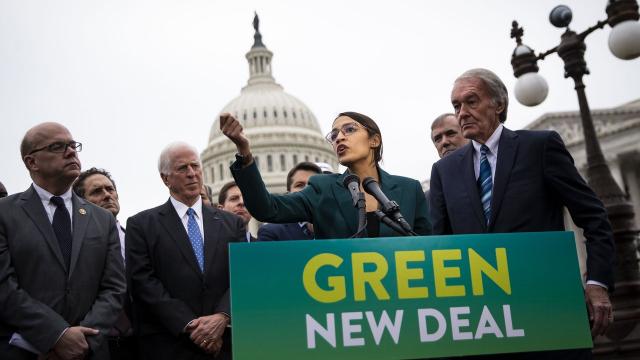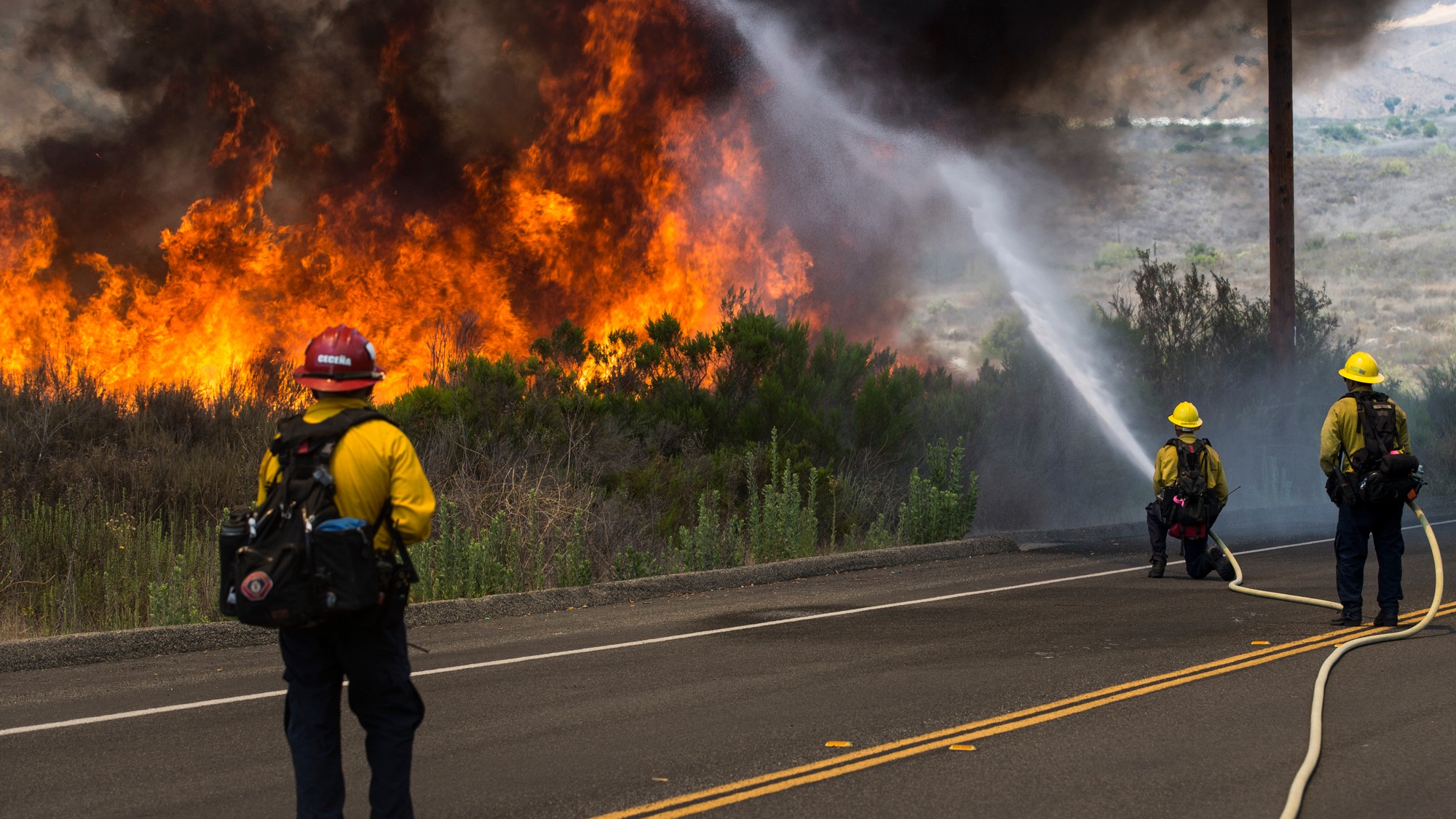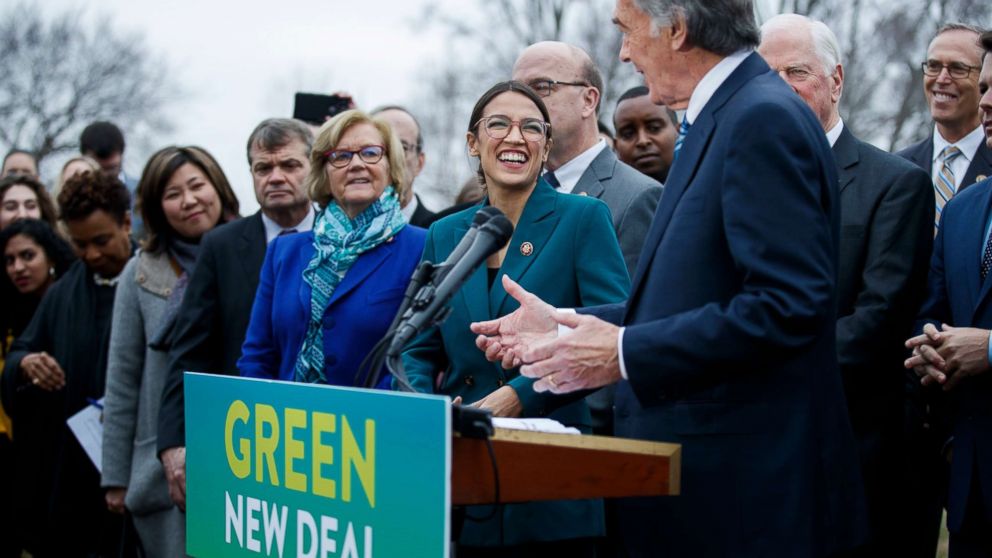
Al Drago/Bloomberg
On Thursday, a resolution for the Green New Deal—a climate change-focused public infrastructure bill spearheaded by Congressperson Alexandria Ocasio-Cortez—was released to the public.
The resolution is just that—a resolution, and not an actual bill. So it doesn’t get into nitty-gritty details as to exactly how it will achieve net zero emissions by 2050, a goal recently stated by the Intergovernmental Panel on Climate Change (IPCC) to be the only way to keep warming to below 1.5 degrees Celsius above pre-industrial, late-nineteenth century levels.
However, the resolution does establish a set of values, and names stakeholders that should be included in an eventual Green New Deal bill. The resolution specifically states that the Green New Deal bill will create “appropriate ownership stakes” for the public, support ‘community grants, public banks, and other public financing.” In short, the resolution places public ownership front and center.
This may sound abstract. However, there’s an excellent way to ensure that the public has ownership in Green New Deal assets, and has agency in a world with the Green New Deal: Nationalize public utilities.
The urgency for nationalizing public utilities could not be more poignant. Last week, private natural gas and electricity utility Pacific Gas and Electric Company, better known as PG&E, filed for chapter 11 bankruptcy. It is currently facing $30 billion in liability fees after a state investigation found that it caused at least a dozen wildfires back in October 2017. The wildfires, sparked by downed power lines, killed at least 46 people and burned more than 200,000 acres of land.
Because PG&E is a private utility company that’s filing for bankruptcy, the company’s tragic mistake is going to cost state residents for years. Per legislation passed at the state level this past September, ratepayers legally have to bear financial responsibility for damage caused by PG&E by paying higher rates for PG&E services. This explains why the California Public Utilities Commission (CPUC), which is in charge of regulating private and public utilities in the state, approved a plan to let PG&E take out $6 billion in loans that will also be funded by ratepayers.
But it doesn’t have to be this way. Right now, PG&E is an investor-owned utility, meaning that the company's express purpose is to maximize the return on investment for stockholders. This affects everything from its management structure to the rates people have to pay for gas and power.
Johanna Bozuwa, a research associate at the Democracy Collaborative focused on the fossil fuel economy, told Motherboard in a phone call that investor-owned utilities also operate with disproportionate power in de facto regional monopolies. “The reality is that these monopolies have a lot of power and often will regulate their own regulators,” Bozuwa said.
Bozuwa explained that investor-owned utilities will often spend their money on lobbying and campaign contributions. In 2018, PG&E spent$8.89 million on lobbying, and $1.29 million on campaign contributions (including $52,010 for Democratic Senator Dianne Feinstein).
Investor-owned utilities are set up to prioritize short-term investor profits and not represent the long-term interests and well-being of the people who pay for those utilities. Bozuwa told Motherboard that since companies like PG&E have standard, dirty energy assets, they’re not incentivized to invest in clean energy.
“It’s not only that they have a lot of fossil fuels, it’s that their entire system has operated off of fossil fuels, and they’ve figured out how to make money off of that process,” Bozuwa said.
“So being pushed towards taking climate change seriously and shifting towards renewables… those are all things that are contrary to the investor-owned utility model that makes money specifically off of what they call capital infrastructure and guaranteed rate of return.”
The alternative is a publicly owned utility. According to the CPUC, the ownership structure for a publicly owned utility involves a local government body, and maybe customers and people who live in the area. This group of people would be responsible for setting the rates, and operating and investing in new facilities. Publicly owned utilities can also be financed through tax-free bonds and co-ops for people who can afford to pay in.
This essentially means that communities can decide to achieve “net-zero greenhouse gas emissions through a fair and just transition,” as outlined in the Green New Deal resolution, and invest in forms of renewable energy such as solar, wind, and water power.
According to a study published in the Canadian Journal of Economics that focused on public and private electricity utilities in the US, “all but the largest publicly owned utilities deliver distribution services at lower costs than do their privately owned counterparts.” The study also found that publicly owned utilities tend to provide more reliable, higher quality services.
There are already small publicly owned utilities operating on the local level all around the US. Forty-six municipalities in California—including major cities Sacramento, Los Angeles, and Palo Alto—already have publicly owned electricity projects that provide some services to their residents. But these are smaller projects when compared to PG&E, which has a de facto monopoly in the California region with 16 million customers.
The Local Green Energy Alliance, Community Choice energy, and other grassroots organizations in the East Bay Area are currently campaigning to block the CPUC’s efforts for a de facto PG&E bailout. And of course, California isn’t the only state fighting investor-owned utilities. Currently, there’s a campaign in the state of Rhode Island to convert National Grid services to public ownership.
Meanwhile, investor owned utilities continue to put ratepayers at risk, and PG&E isn’t the only example. Take Con Edison, which serves the New York region, for example. In December, a transformer explosion turned the entire New York City sky aqua blue and put thousands of residents in the dark.
According to Bozuwa, if PG&E were to be publicly owned, it could potentially be designed to empower these local projects and regional distributors, as well as Community Choice Aggregators, boards that enable opt-on community options for alternative, renewable forms of energy for residents. Seven US states, including California, already have some Community Choice Aggregators, according to the EPA.
“I think it’s about building multiple scales of public ownership, and not thinking about it as like ‘oh, well the state will run all of this at the state level,’ because it’s a very large, very populous state,” Bozuwa said.
For perspective, 2019 is not the first time that PG&E has filed for bankruptcy. Back in 2001, a drought in the U.S. reduced the amount of energy PG&E was able to import from states other than California (climate change makes droughts both more likely and more intense). That, combined with expensive wholesale rates for electricity, drove the company into bankruptcy. In order to keep the company afloat, ratepayers had to pay $1.6 billion over the course of several years, and California had to give the company $3 billion in Energy Recovery Bonds to save ratepayers money.
In 2019 and in years to come, California will continue to face heightened risk for wildfires and droughts—things that could cause PG&E and other investor-owned utilities that rely on dirty-energy infrastructure to go bottom-up again.
An express goal of the the Green New Deal resolution is “to secure for all people of the United 15 States for generations to come…climate and community resiliency.” But we can’t face upcoming decades of climate change with the utility system we have now. If we continue to rely on investor-owned utilities, they will continue to prioritize natural gas. Their systems will fail, wildfires will continue to happen, and ratepayers will pay the cost.













